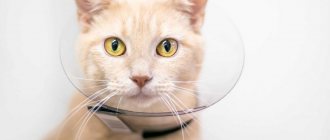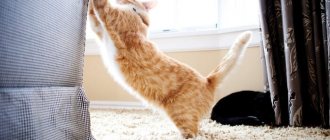When can you take a kitten from a cat: the ideal time to give away kittens
It is better to take a kitten from a cat at the age of 1.5-2 months.
There is no need to rush to remove the baby from the mother.
Veterinarians justify this figure with the following facts:
- kittens feed on mother's milk for 4-5 weeks;
- by the 7-8th week, the babies have already completely switched to adult food;
- after 1.5 months, babies actively explore the territory and are not so attached to the parent, the stress from changing homes will not be so strong.
A significant role is played by the fact that by the age of 2 months, babies have already received their first vaccination and immunity has been developed. The risks of developing dangerous diseases when moving to a new family are reduced.
The kitten begins to try adult food starting from the 3rd week of life.
Earlier weaning of kittens (at 4 weeks of age) is practiced if the litter is large or the mother cat is emaciated (sick).
In this case, the new owners of the animal have an additional burden in the form of feeding the kitten with special mixtures - cat milk substitutes. It is not recommended to replace the special formula with cow's milk.
Vaccinations for kittens: age, what, first vaccination when?
Vaccinations for kittens
The first year of a kitten’s life is filled with all kinds of medical procedures. These are repeated treatments against helminths (worms), external microbes, fleas and vaccination. Veterinarians convince that vaccination is necessary, because without vaccination the body will not deal with infections, and the animal may get sick.
The first vaccination for a kitten is best done at the age of 8-10 weeks . The second injection should be given after 3-4 weeks . If all vaccines are completed, you only need to worry about getting a booster shot once a year. Here is an approximate calendar of injections, treatments and what vaccinations kittens need to receive:
- 4–6 weeks - first treatment for worms
- 6–8 weeks - second treatment for worms
- 9 weeks - first comprehensive vaccination
- 10–12 weeks - third treatment for worms
- 12–14 weeks - second complex vaccination
How to prepare a cat for vaccinations? Here are the tips:
- The main condition before the vaccine is that the animal must be given an anthelmintic drug one or two weeks before.
- There is a huge selection of them, including in the form of treats that the animal will eat with pleasure.
- Can be used in the form of drops on the fur, which will not provoke any protest and will be well tolerated by the cat.
If these conditions are not met, then after vaccination, the cat may contract an infection, and treatment will cost the owner a tidy sum of money. Look at the detailed calendar of vaccinations and treatments for kittens:
How long does it take to wean a kitten, what should they do themselves?
The kitten begins to try adult food starting from the 3rd week of life. Young animals begin to eat the same food that their mother eats.
By the 7th week, all the babies' teeth have erupted and they are ready to completely give up milk from the cat's breast.
Be sure to read:
Sex barrier for cats: release forms, dosage, course of administration, indications and contraindications
By the time the animal moves to new owners, it has some skills that make it easier for new owners to care for it:
- The cat teaches hygiene to the offspring. Babies already know how to lick their fur and wash themselves.
- The period from 1.5 to 2 months is the right time to teach the offspring to go to the toilet in a tray. The children, following their mother, use the smell to find the place where they need to do their business. It is more difficult for a person to explain to a kitten where to go to the toilet.
- The age of 7-8 weeks corresponds to the development of a child 2-3 years old . The animal's behavior is almost no different from children's games: kids explore the territory, try everything, play noisily with their brothers and sisters.
When a baby arrives in the house, you need to prepare not only a tray, a sleeping basket and food, but also several suitable toys: a ball, a soft toy, a rubber mouse.
Proper kitten care
When purchasing a pet, you should take care of all accessories, including a tray, which must match the size of the animal.
In order for the cat to quickly adapt, it would be correct to purchase the following contents in advance:
- Tray. If the baby is less than 5 weeks old, you need a basin with low sides. It is better to choose a regular plastic tray; closed toilets are not suitable for babies. Wood or corn filler is suitable. Silica gel primer contains chemical impurities, so it is not suitable for children.
- Scratching post. When your baby first appears indoors, you should show him where he will sharpen his claws. You need to train it from the first days, otherwise the kitten will damage the furniture. You can make a scratching post yourself from a piece of an old rug and hang it on the wall, decorating it with movable soft pet toys.
- A bowl. You will need 3 of them - for dry and wet food, water. It is better to choose ceramic or plastic. Metallic ones can oxidize food and water.
- Sun lounger. It is better to place month-old babies in a box with woolen fabric on the bed. For older cats, a bed with low sides is suitable. Some cats choose their own resting place, so if it is safe there, you can leave it there.
- Ear and eye hygiene. Particular attention should be paid to the ears of a Scottish cat, since due to the special structure of the ears, dirt accumulates inside and bacteria develop. The baby’s hearing and vision organs are wiped with special animal products “Beafar”, “Trixie”, “Diamond Eyes”.
- Grooming. For delicate fur, a wooden comb with frequent short teeth is suitable. When an animal sheds hair, combs are purchased based on the length and thickness of the fur and undercoat.
The baby is very curious and climbs everywhere, so it is advisable to put protective plugs on the sockets and put the wires out of sight, since the kitten can touch it with its claw and get an electric shock.
How to wean a kitten from mother's milk?
At the age of 2 months, animals no longer need milk.
It is difficult to overestimate the importance of mother's milk for a kitten: with it, the baby receives not only nutrients, but also the necessary antibodies to strengthen the immune system.
But at the age of 2 months, animals no longer need milk as the only source of nutrition. They can continue to suckle a cat simply out of habit for up to six months. Usually the cat itself drives away annoying teenagers, keeping them away from the nipples.
Advice! If older kittens do not give the cat rest, tugging at her nipples, she is given a fabric blanket. It is necessary to ensure that milk does not accumulate in the nipples. If lactation is not yet completed, once a day the young animals are allowed to suck the milk from their mother.
You can make the transition to adult feeding easier for the cubs by additionally providing dairy products: yogurt with natural sourdough, without sugar and fruit additives, low-fat cottage cheese.
The main food for a baby weaned from a cat is meat: boiled beef and chicken, rabbit. You can give special canned meat for kittens.
Be sure to read:
How to calm a cat that asks for a cat at home
What does a cat need in the house?
In principle, any cat can get along in an apartment. She does not require special care, you do not need to walk with her. But some accessories are still worth purchasing.
- Tray. It is advisable that it be filled with filler, because furry pets love to bury everything. Gradually, as the baby grows up, the powder can be eliminated, but only after a habit has formed.
- Scratching post. If you don't want your cat to ruin your sofa or wallpaper, buy her a claw sharpening machine at the pet store.
- Mouse toy. Not every person is able to devote a lot of time to a pet, play with it or caress it. To prevent your animal from getting bored, buy him a mouse toy. Someday she will still end up in the corner under the sofa, but the furry one’s happiness will be immeasurable. This further trains the hunting skill.
- Pillow for sleeping. Many animals ignore such care from the owner, but if the pet has not reached the period when the kitten can be taken away from the cat, then it is possible to train it to sleep in a certain place.
How to introduce kittens to solid food?
The process of accustoming a young body to adult food takes a couple of weeks.
As a rule, by the time the baby becomes interested in the contents of the mother's bowl, several teeth have already erupted. The kitten is offered soft cottage cheese, slightly diluted with yogurt or cat milk replacer.
At another feeding they offer meat pate. Gradually, you can replace finely ground food with small and then large pieces.
Breeders feed the cubs 2-3 times a day, taking them away from their mother to another room. The food is distributed into bowls and each kitten's face is lightly dipped into the food.
The process of accustoming a young body to adult food takes a couple of weeks.
Starting to lick his lips, the baby involuntarily eats the first portions of food. The amount of food should not be large, 1 teaspoon is enough.
So that kids don’t get scared in an unfamiliar environment, they communicate with them: they talk affectionately, pet them.
At what age are kittens measured?
Little kittens
Metrica is an officially issued birth certificate for a pet. This is a kind of identity document, like a passport for people. Only the metric contains other data that indicates its pedigree.
This document states:
- Date, month, year of birth
- Breed name
- Gender of the animal
- Pet name
- Color
- Mother's nicknames for father
- Parents' color
- Breeder's initials
- Owner's initials
- Signature and seal of the organization where the document is issued
To get a metric, the owner needs to contact a cat lovers club in any city. Before filling out the document, kittens are examined for defects. If there are none, the metrics are signed and certified with a seal. A certificate for a pet can be made at an age starting from 45 days .
What to do if the kitten is left without a mother?
Newborn kittens must be kept warm. To imitate the warm side of their mother for them, a heating pad with hot water is placed in the box with the babies. The temperature of the heating pad should be 40 degrees.
Babies are fed from a pipette or a special nipple. Cat milk or its substitute can be purchased at a pet store or veterinary pharmacy. The mixture is heated to a “steamy” temperature (this is +38 degrees) and fed to the babies.
The problem is the frequency of feedings per day. Up to 2 weeks, the cub should eat every 3 hours. From 2 to 4 weeks, the intervals between meals are increased to 4-5 hours. From 5 weeks, kittens are fed 4 times a day.
The care system for a newborn pet looks like this:
- feeding the baby itself;
- massage the tummy and inner thighs to facilitate toileting using gentle circular movements;
- wiping with a damp cloth under the baby's tail.
In the future, artificially raised pets will not differ from ordinary kittens.
Be sure to read:
What time do kittens start walking and when do their eyes open?
At what age should kittens be bathed?
The kitten's first bath
In the first weeks of life, the kitten's hygiene is maintained by the cat herself. Therefore, during this period you should refrain from swimming. At what age should kittens be bathed?
- It is best to do this at 3-4 months , after the baby teeth have been replaced.
- This age guarantees that the body will tolerate the procedure well and that mental disorders will not occur.
Of course, you need to perform bath procedures when it is relatively warm in the house and outside. During cold weather it is better not to take risks. Read more in the article at this link , you need to bathe kittens in general, because many owners are sure that this is not necessary.
Worth knowing: You should not bathe kittens with human shampoo - it is best to purchase a special one. It would also be a good idea to check the composition - for children it is better to use a product that has natural ingredients.
Correct Methods
To wean a kitten from cat sucking without psychological trauma, you need to act gradually and slowly. Believe me, your pet will help you, because she will not allow kittens with teeth to bite her nipples. Babies will be hungry, so they will be more willing to switch to complementary foods.
Sucking is not only a way to eat, but also tactile contact.
Most kittens older than 3 weeks suckle their mother only because they lack communication, like the smell, etc. Simply put, kittens are childishly attached to their mother and do not want to change this. If you carefully observe adult kittens, many of them suck not the nipple, but the mother’s fur, trample it with their paws, purr - this is communication that the mother cat will not object to.
What are the consequences of delaying the issue of weaning off sucking?
Unfortunately, childhood cannot be prolonged; the kitten will have to grow up and learn to communicate with others differently. If a kitten, separated from its mother, continues to suck... the owner’s hands, clothes, blanket, it becomes morally attached to the “object of addiction”. There is nothing catastrophic in this, but such behavior cannot be called normal either.
There are several methods for weaning a kitten from sucking:
- Games
- at 3-4 weeks of age, babies are very playful, their attention can be attracted by the noise, rustling or squeaking of a toy. Introduce feeding on a schedule, and the rest of the time, as soon as the kids rush to the cat, distract them.
- Time
- Most kittens stop nursing without intervention. This happens after the kittens gain self-confidence and a sense of “own self.” The baby may retain the habit of stomping, but this behavior is also characteristic of many adult cats.
- Pacifier
- the kitten is first accustomed to the bottle and the mixture, and then the mixture is poured into a saucer and the baby is taught to lap. In this method, the transition occurs gradually, since the smell of food plays a very important role during sucking. That is, you change familiar things in stages, first the smell, then the method.
Timing and general information about feeding kittens
The sucking reflex develops in kittens during the prenatal stage. When a baby is born, guided only by smell, he crawls to the nipple. The colostrum that kittens drink promotes the proper formation of intestinal microflora. When the kittens' microflora is ready to digest milk, the colostrum changes composition.
Mother's milk provides nutrients and immunity (antibodies) to babies. How long the kittens will receive milk is decided by the cat herself; believe me, she knows best when the kittens are ready for complementary feeding and are developed enough for this. Statistically, breastfeeding lasts 14-15 weeks. Depending on the rate of formation, the cat may begin not to feed the babies at 8-12 weeks.
If no changes in feeding have occurred before 12 weeks, no intervention on your part is required. If
the cat refused to feed
the offspring at 8 weeks or earlier, the kittens need supplementary feeding (milk) or complementary foods (adult food for older kittens).
Kittens receiving supplemental feeding or complementary feeding should be weighed regularly. It is very difficult to visually determine whether the baby is lagging behind in weight. Based on the experience of breeders, litters of 3-4 kittens do not need supplemental feeding. If 5 or more kittens were born in a litter, the two babies who were born last are given additional attention, if necessary, additional feeding.
As long as the cat is not showing concern and is feeding the kittens, do not interfere. Under no circumstances should you use harsh methods of behavior correction or limit contact between a cat and kittens if they want to communicate. All animals undergo a natural weaning process. You may have to be patient, think about your children’s diet, and seek advice, but we assure you that you can always do without traumatizing the psyche.
Important!
Methods that should not be used are coating the cat's nipples with something bitter and splashing water on the kittens.











